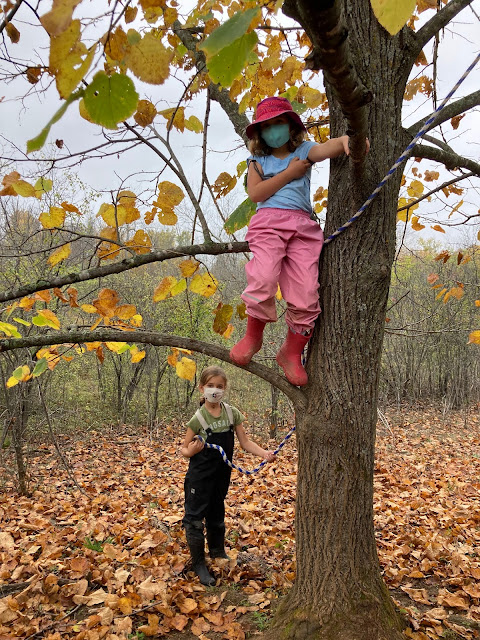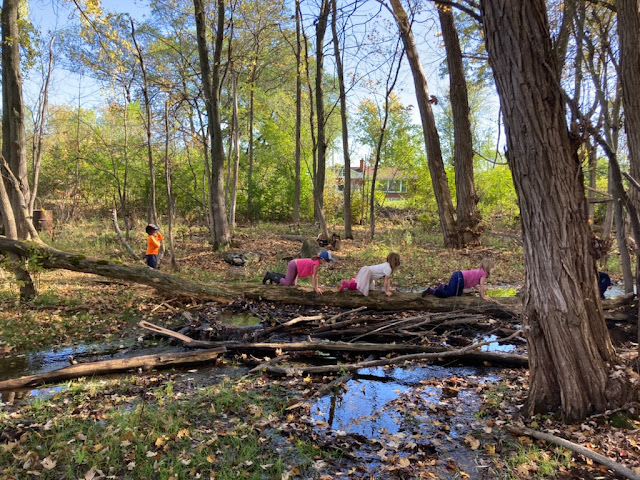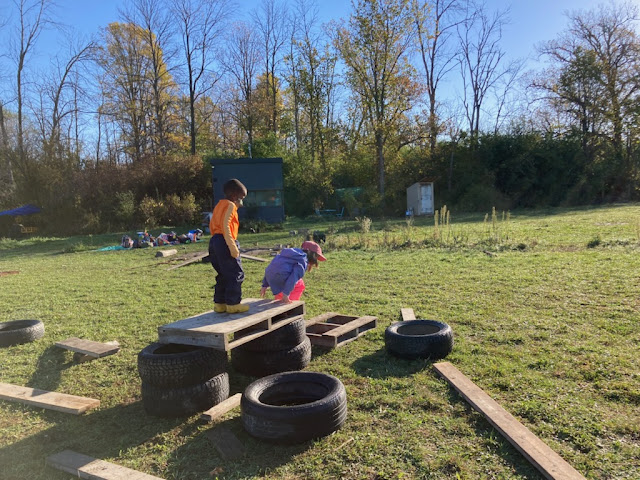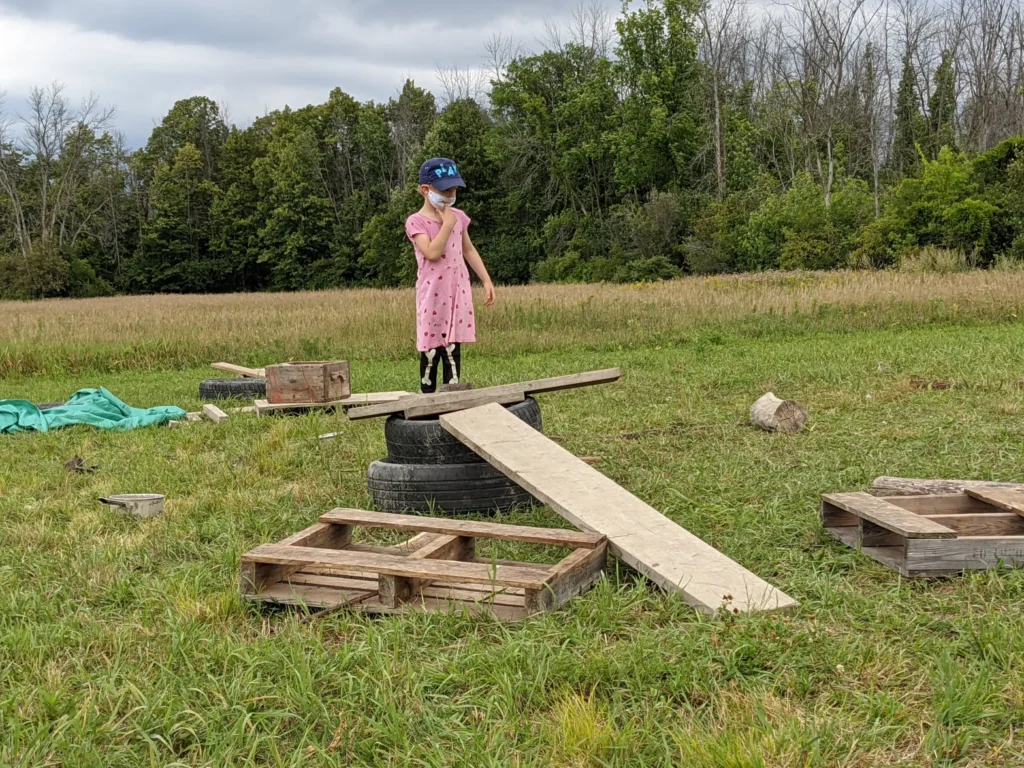We encounter risk each day on the land. We don’t post a list of rules at the entrance to the forest that details what cannot be done, a la don’t do this, don’t do that. That approach does not fit with our belief that children are competent and capable of making smart and kind decisions. Rather than make blanket statements about what can and can’t be done, we work together to make decisions.

We are not flippant and cavalier. We have pages and pages of Risk Benefit Assessments for many experiences and throughout the seasons, which we review on a regular basis, informing our process each day. Climbing on rocks is okay, but not all rocks with all groups on all days. How many children are in the group? How old are they? How long have we known them? What is the weather like- rainy? Sunny? Icy? Blowing snow? Have we climbed at these rocks before?
Every day on the land we have a pretty good idea of what sorts of play will emerge, and everyday we are surprised by something new- a new spot that calls to be investigated, a new hazard hanging over a picnic spot in the form of a fallen tree, a new discussion that is required since the rocks we were hopping on last week are now covered in leaves and are much more slippery than before.
We talk together as a staff team about the experiences that tend to emerge, come up with plans about how to mitigate the risks so the children can play safely enough, document and modify these plans as needed. (We really do have pages and pages of them.)
There are times when a situation emerges that requires us to make decisions on the fly. We encounter a place or way to play that we have not encountered before, and we have not thought through these specifics before. This is when we need to do a Dynamic Risk Assessment.
I gather the group together, and go through a process.
Identify why I feel uncomfortable- ask “what seems unsafe?”
Describe my concerns to the group.
Enlist help from the group finding a way to move forward together that is kind and safe.
Remind the group that if I remain uncomfortable or something changes we will gather again and make another decision.

Here is an example from a winter play session.
Working with a Kinder class in a school yard, an icy hill went from being an interesting place to mine, to an urgent and necessary place for everyone to climb at once.
I hooted everyone over to have a seat in our “nest”. I told them that watching them play on the icy hill made my tummy uncomfortable–I was worried that someone was going to get hurt in a big way. I asked:
Is it ok to fall down? (We’d been over this before.) Yes!
Is it okay to get a bump and stay down for a while until you feel like getting back up to play? Yes.
So why did the group think I was feeling uncomfortable about this situation.
Children offered ideas such as:
- the ground is frozen hard so it hurts when we fall
- we might hit our heads
- if we are on top and fall it is a long way down (maybe 4 feet)
- it is slippery on top so we slide on top of each other
- the parking lot is on the other side and we might slide into cars
- people push when we are on top
The children, as always, were very good at identifying what the safety issues might be.
I asked if they wanted to play on that hill. Some said yes, some no. I told them we could try, and we would have to agree on how to do it safely. We came up with a plan together.
What can we do about falling from a height and banging our heads?
I reminded them about the raccoons from our morning story, who crawled and climbed on all fours, who could slip and fall and didn’t hit their heads. We agreed that climbing would happen on all fours, like the raccoons, even when we got to the top of the hill.

What could we do about sliding down the other side into the parking lot?
We set up a rope to act as a boundary that we would not cross that would help us remember to stay away from the parking lot. A parent agreed to stand in that area to remind children to watch out for the parking lot, and as a warning for any drivers who might come by. (We never set up to play in an area that is close to traffic- there was a space cushion built in before a child would end up in the parking lot, but it was open space, so we took that concern very seriously.)
What about people being pushed on top, and sliding on top of each other?
Staying on all fours like a raccoon should help with that. I said that I still felt uncomfortable with the idea of someone being pushed off the top. A teacher suggested we only have 5 friends on the hill at a time. The children did not all love this idea, but they agreed to it so that they might have a turn to scale the snowy mountain.
I asked if everyone could agree to these steps to stay safe. They said yes. I told them we would remind each other and that I believed in them. I also told them that if it became too hard to play on the hill safely that was a sign we should shut it down, choose other ways to play, and that we could check it out again next week.
We went back to play, and of course there were a few hiccups, but overall the play near and on the snowy mountain was quite smooth.
This process went very smoothly this day. It was morning so our energy levels were in good shape, we had just had a story that was relevant to the play that would emerge, we had gone for a hike around the schoolyard to get our bodies moving and to work out the sillies a bit, and it was our third week together. These all contributed to the process going well.
Each situation is unique. We do not always have parent volunteers to help keep an eye on one side of the hill. Children are not always able to contain their excitement and energy to be able to safely take turns, so we close off an area, or walk to a different location to play, or take the swing down if that is the issue. We cannot always say, “Yes, how can we do it safely?” Sometimes we need to say “This does not feel safe. I need for us to choose another way to play.”

The key is that when a play situation arises that makes us feel uncomfortable in our guts, we listen to our guts, pause the play, then talk with the children to try to find a way to move forward together.
Being able to do a Dynamic Risk Assessment allows us to pause play and work together to find smart and safe solutions, rather than always needing to say no right away. I’m grateful to have this approach as a way to work together with children to navigate the risk that emerges in their play. When we take the time to work together and listen to each other, we usually find a way to make the play happen.

